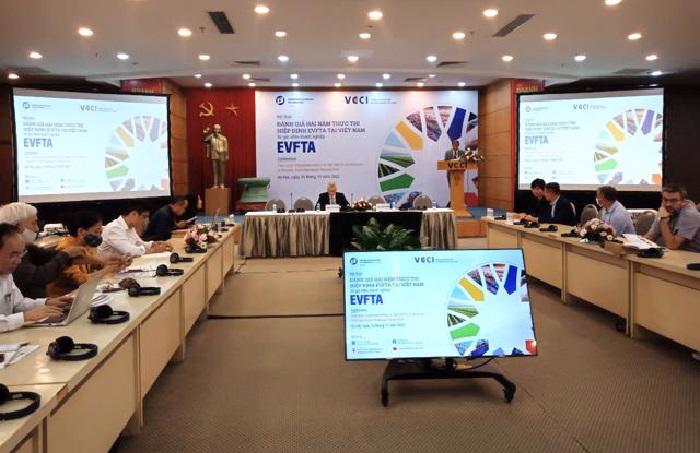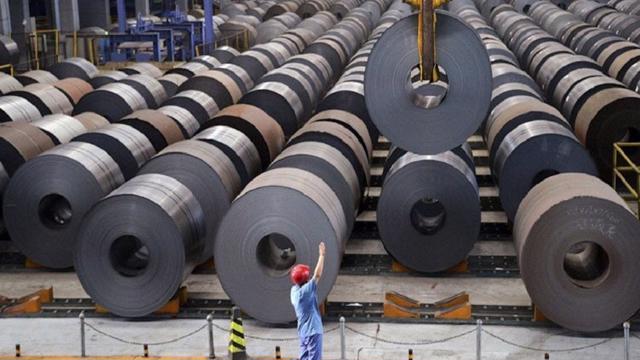[ad_1]
On November 10th, the Vietnamese Chamber of Commerce and Industry (VCCI) in coordination with the Vietnamese FNF Institute organized a workshop on “Evaluation of the two-year implementation of the EVFTA agreement in Vietnam from a business perspective”.
OVER 40% OF COMPANIES ENJOY AT LEAST ONE EVFTA BENEFITS
Seminar summarizing 2 years of implementation of the Vietnam – European Union Free Trade Agreement (EVFTA) both from the point of view of trade – investment and construction legislation – institutions in Vietnam, as well as publishing the newspaper at the same time. The report “Vietnam After 2 Years of Implementing EVFTA from a Business Perspective” was prepared by the VCCI with the support of the FNF Institute, based on the results of a survey of more than 500 companies across the country and a review of documents. Legislation implementing EVFTA in the last two years.
Mr. Hoang Quang Phong, Vice President of the Vietnam Chamber of Commerce and Industry, said at the workshop that the first two years of the implementation of the EVFTA agreement is also the time when the global economy and Vietnam are facing unprecedented fluctuations, from the Covid -19 epidemic, the disruption of supply chains, to the Russia-Ukraine conflict, the capacity crisis, food…
However, macro statistics show that the EVFTA has played an important role in mitigating negative impacts and has helped develop positively the trade and investment relationship between Vietnam and the EU.

In terms of trade, the total export turnover from Vietnam to the EU in the first two years of implementation (August 2020 to August 7, 2022) reached US$83.4 billion, or an average of US$41.7 billion per year, up to 24 times higher compared to the average export turnover of the previous year 2016-2019.
The share of exports taking advantage of the EVFTA tariff stimulus will reach 14.8% in 2020, rising to 20.2% in 2021 and 24.5% in the first 6 months of 2022.
In terms of foreign direct investment (FDI) attraction, EU FDI in Vietnam reached nearly USD 1,376 million in registered capital in 2020, down 8.6% from 2019, ranking 8th and 4.8% of the total capital.
In 2021, the situation will improve, with a total capital of more than USD 1,405 million, an increase of 2.2%, which will help the EU climb to the 5th place, but the proportion of the total foreign direct investment is slight decreased and accounts for 4.5%.
In particular, the average total investment capital in the period 2017-2021 (the period after the completion of the EVFTA) increased by 86% compared to the previous period 2015-2016. However, investments in Vietnam represent a very modest share of the EU’s total foreign investments (0.35% in 2021).
According to Ms. Nguyen Cam Trang, Deputy Director of Import-Export Department, Ministry of Industry and Trade, the EVFTA has been instrumental in boosting Vietnam’s exports to partner markets.
In particular, many of Vietnam’s export products have seen impressive growth in the EU market in the two years of implementation of this agreement (e.g. iron and steel by 739%; cameras, camcorders and components by 739%; 260%; machinery and equipment by 82.3% increased…).
Some new products also show high growth in the EU market during this period, such as rice, bamboo and rattan products, carpet harrow (up over 50%); ceramics and porcelain products (up more than 25%); Vegetables and fruits group, electrical wires and cables (up more than 15%)…
Sharing the results of a business survey on EVFTA, Ms Nguyen Thi Thu Trang, director of the Center for WTO and Integration (VCCI), said the percentage of Vietnamese companies that have benefited from the EVFTA is very positive, with almost 41% them had at least gained some benefit from EVFTA.
The most common advantages are tariff preferences on imports and exports and positive effects in the form of higher orders, sales and profits. According to Ms. Trang, this could be the result of companies’ improved understanding of this agreement.
According to the survey, nearly 94% of companies have heard or known about this agreement to some degree, the highest among implemented FTAs. Out of 10 companies, there are 03 companies that are fairly well aware and 01 companies are very well aware of EVFTA obligations related to their business activities.
9 LEGAL DOCUMENTS AMENDED, SUPPLEMENTED AND PUBLISHED
In preparing legislation to implement EVFTA, VCCI’s review results show that in the past 2 years, a total of 9 legal documents have been amended, supplemented and issued to implement obligations, particularly in 06 Chapters and 01 Protocol of the EVFTA document.
Although drafted faster than usual, most legal documents implementing EVFTA are being released slowly compared to the required milestone of the agreement of August 1, 2020 (average of legal documents 632 days late).
While all of these documents ensure compliance with the commitment requirements (through provisions for retrospective application, direct application or otherwise), the delay in issuance still impacts the effectiveness of the project.
In terms of the level of compliance, according to Ms Trang, the review shows that most of the provisions in the legal documents implementing the EVFTA are compatible with the obligations of the agreement, that they are “internalised”.
In some cases, the regulations even implement commitments at a higher level than required or with an earlier timetable (notably the EVFTA package tendering regulations).
However, there are still some cases where the “internalisation” regulation has not fully met the obligation (e.g. regarding intellectual property) by adding additional conditions limiting the right to preferences (e.g . the conditions for the late submission of proof of origin) or the current legal situation has not yet ensured the actual implementation of the EVFTA obligations (e.g. on the freedom of association of employees).
[ad_2]
Source link

